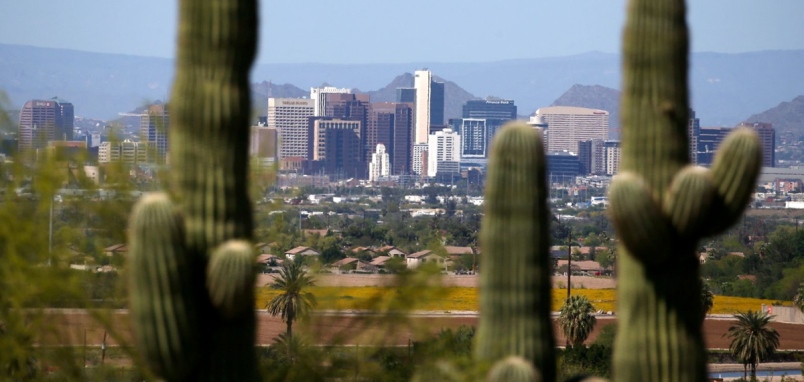Pictured: Smog in cities such as Phoenix has all but disappeared during the weeks of social-distancing.
Photograph By ROSS D. FRANKLIN, THE ASSOCIATED PRESS
Courtesy of the Times Colonist
Because of Covid-19 we stand yet again at a crossroads of history. Too often in my lifetime we have stood at this same crossroads, and each time we have taken the wrong path. Will we get it right this time?
The crossroads I refer to is, at its simplest, the choice between what James Robertson, a British alternative futurist, called the HE and SHE futures, in his infuential 1978 book, ‘The Sane Alternative’. HE stands for hyper-expansion, a high growth, high tech future, business as usual on steroids. SHE stands for sane, humane and ecological, where sanity is about balance within ourselves, humanity is about balance between ourselves and the rest of humanity, while ecology is about balance between humanity and the Earth and all its species.
The HE future is the path we have been following since at least the end of the Second World War. The SHE future is the path we have consistently avoided, but is our only real choice if we and the rest of humanity are to live good quality lives within the limits of the Earth.
One opportunity where we had this choice was in 1972, at the time of the First UN Conference on the Environment in Stockholm. It was a time of globally significant books and reports such as Only One Earth, The Limits to Growth and Blueprint for Survival.
The Stockholm Declaration stated: “Through ignorance or indifference we can do massive and irreversible harm to the earthly environment on which our life and well-being depend. Conversely, through fuller knowledge and wiser action, we can achieve for ourselves and our posterity a better life in an environment more in keeping with human needs and hopes.”
Following the conference, sadly, we opted for massive and irreversible harm to the earthly environment. The failure to make the choice to deal with climate change in the decade from 1979 to 1989 was documented in a lengthy article by Nathaniel Rich in the New York Times Magazine in August 2018. As the Magazine’s Editor noted, “It will come as a revelation to many readers — an agonizing revelation — to understand how thoroughly they grasped the problem and how close they came to solving it”.
That pattern of grasping the problem but failing to make the right decisions continued throughout the 1980s and 1990s, and into the new millennium. The 1987 report of the UN Commission on Sustainable Development, “Our Common Future”, identified our responsibility to future generations and noted that humanity’s activities are “changing planetary systems, fundamentally. Many such changes are accompanied by life-threatening hazards. This new reality, from which there is no escape, must be recognized – and managed.”
This led to the 1992 UN Conference on Environment and Development in Rio de Janeiro; the Declaration stated: “Human beings are at the centre of concerns for sustainable development. They are entitled to a healthy and productive life in harmony with nature”, adding that “The right to development must be fulfilled so as to equitably meet developmental and environmental needs of present and future generations”.
In 1989, midway between these two events, in its annual report on the state of the world, the Worldwatch Institute dubbed the 1990s “the turn-around decade”, the decade when we really needed to change: We did not turn.
As I have noted in recent columns, the enforced pause in our social and economic lives due to the Covid-19 pandemic gives us the space and time to consider whether we want to go back to the bad old ways, or choose a different path, one that holds out the hope of creating a sane, humane and ecological future.
I am not alone in seeing the opportunity we now have to make the right choice. Writing in the Guardian on April 1st, UN Secretary General Antonio Guterres said “We simply cannot return to where we were before Covid-19 struck . . . Now is the time to redouble our efforts to build more inclusive and sustainable economies and societies that are more resilient in the face of pandemics, climate change and other global challenges. The recovery must lead to a different economy”.
This time, will we choose the right path? Our descendants certainly hope so.

Thanks for your webinars – they are inspirational to the max. Keep up the great work. Love, Jim